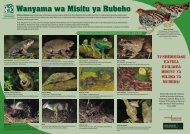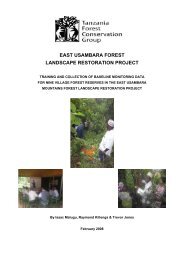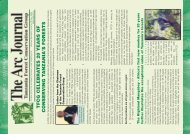Assessment of the biological values of different land cover types in ...
Assessment of the biological values of different land cover types in ...
Assessment of the biological values of different land cover types in ...
You also want an ePaper? Increase the reach of your titles
YUMPU automatically turns print PDFs into web optimized ePapers that Google loves.
genus Albizia were also recorded <strong>in</strong> <strong>the</strong> forest reserves. The tree species <strong>in</strong>cluded Millettia usaramensis.<br />
Twelwe (12%) <strong>of</strong> <strong>the</strong> tree species were found <strong>in</strong> <strong>the</strong> mixed farm<strong>in</strong>g areas, <strong>of</strong> which one species; Dialium holtzii<br />
was also recorded <strong>in</strong> <strong>the</strong> forest reserves. In <strong>the</strong> <strong>land</strong> <strong>cover</strong> type consist<strong>in</strong>g <strong>of</strong> a mosaic <strong>of</strong> fallow <strong>land</strong>,<br />
agr<strong>of</strong>orest and monoculture, three (3%) tree species were recorded, <strong>of</strong> which none were recorded <strong>in</strong> <strong>the</strong> forest.<br />
Six (6%) <strong>of</strong> <strong>the</strong> tree species were recorded <strong>in</strong> <strong>the</strong> monoculture and mixed farm<strong>in</strong>g areas, <strong>of</strong> which none were<br />
recorded <strong>in</strong> <strong>the</strong> forest. In <strong>the</strong> teak plantation, twelwe (12%) tree species were recorded, <strong>of</strong> which none were<br />
recorded <strong>in</strong> <strong>the</strong> forest.<br />
Table 4. Tree species recorded <strong>in</strong> <strong>the</strong> <strong>land</strong>scapes <strong>of</strong> <strong>the</strong> East Usambara Mounta<strong>in</strong>s.<br />
Vegetation/Land <strong>cover</strong> type Number <strong>of</strong> tree Number <strong>of</strong> tree species also<br />
species recorded recorded <strong>in</strong> <strong>the</strong> forests<br />
Village forest reserves 58 -<br />
Agr<strong>of</strong>orests 24 9<br />
Fallow <strong>land</strong>s 18 3<br />
Mixed farm<strong>in</strong>g plot 12 1<br />
Fallow <strong>land</strong>, agr<strong>of</strong>orest and<br />
3 0<br />
monoculture plot<br />
Monoculture and mixed farm<strong>in</strong>g plot 6 0<br />
Plantation 12 0<br />
Out <strong>of</strong> <strong>the</strong> shrub species, six (35%) species were recorded <strong>in</strong>side <strong>the</strong> village forest reserves (table 5). Seven<br />
(41%) species were recorded <strong>in</strong> <strong>the</strong> agr<strong>of</strong>orest plots, <strong>of</strong> which two were also recorded <strong>in</strong> <strong>the</strong> village forest<br />
reserves. The list <strong>in</strong>cludes Whitfieldia elongata and Piper capense. Five (29%) <strong>of</strong> <strong>the</strong> shrub species were<br />
recorded <strong>in</strong> <strong>the</strong> monoculture and mixed farm<strong>in</strong>g plot. Six (35%) <strong>of</strong> <strong>the</strong> shrubs were recorded <strong>in</strong> <strong>the</strong> fallow <strong>land</strong>s,<br />
one (6%) <strong>of</strong> <strong>the</strong> shrubs were recorded <strong>in</strong> <strong>the</strong> mosaic <strong>of</strong> fallow <strong>land</strong>, agr<strong>of</strong>orest and monoculture plot and one<br />
(6%) <strong>of</strong> <strong>the</strong> shrub species was found <strong>in</strong> <strong>the</strong> mixed farm<strong>in</strong>g plot. Of <strong>the</strong>se species, none were recorded <strong>in</strong> <strong>the</strong><br />
village forest reserves.<br />
Table 5. Shrub species recorded <strong>in</strong> <strong>the</strong> <strong>land</strong>scapes <strong>of</strong> <strong>the</strong> East Usambara Mounta<strong>in</strong>s.<br />
Vegetation/Land <strong>cover</strong> type Number <strong>of</strong> shrub species Number <strong>of</strong> shrub species<br />
recorded<br />
also recorded <strong>in</strong> <strong>the</strong> forests<br />
Village forest reserves 6 -<br />
Agr<strong>of</strong>orests 7 2<br />
Fallow <strong>land</strong>s 6 0<br />
Mixed farm<strong>in</strong>g plot 1 0<br />
Fallow <strong>land</strong>, agr<strong>of</strong>orest and<br />
monoculture plot<br />
1 0<br />
Monoculture and mixed<br />
farm<strong>in</strong>g plot<br />
5 0<br />
Plantation 1 0<br />
Out <strong>of</strong> <strong>the</strong> herb species, only two species (6%) were recorded <strong>in</strong> <strong>the</strong> village forest reserves. Twentytwo (71%)<br />
were recorded <strong>in</strong> <strong>the</strong> agr<strong>of</strong>orest plots, out <strong>of</strong> which one was recorded also <strong>in</strong> <strong>the</strong> village forest reserves. Eleven<br />
herb species (35%) were recorded <strong>in</strong> <strong>the</strong> fallow <strong>land</strong>s, eight (26%) herb species <strong>in</strong> monoculture and mixed<br />
farm<strong>in</strong>g plot while four herb species (13%) were recorded <strong>in</strong> <strong>the</strong> mixed farm<strong>in</strong>g plot, as well as <strong>in</strong> <strong>the</strong> mosaic <strong>of</strong><br />
fallow <strong>land</strong>, agr<strong>of</strong>orest and monoculture. In <strong>the</strong> plantation, two herb species were recorded. None <strong>of</strong> <strong>the</strong> herb<br />
species recorded on <strong>the</strong> <strong>land</strong> uses o<strong>the</strong>r than agr<strong>of</strong>orests was also recorded <strong>in</strong> <strong>the</strong> village forests (table 6).<br />
7






